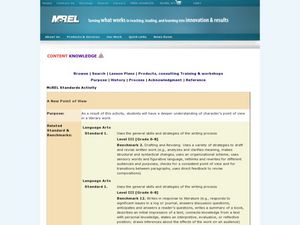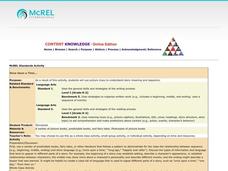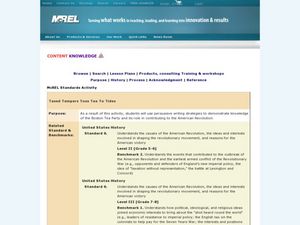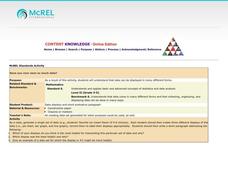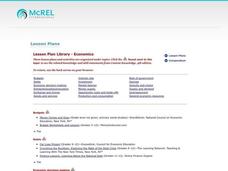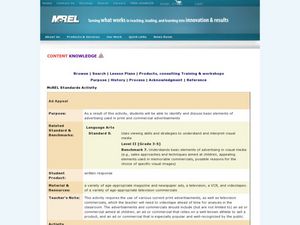Curated OER
Eva's Code
Students understand the importance of punctuation in a sentence. In this codes lesson, students write a pen pal letter using codes for the punctuation. Students send a key to break the code if needed.
Curated OER
Is It Fact or Opinion?
Distinguish between fact and opinions in this nonfiction reading lesson plan. Middle schoolers read 'The Diary of an Early American Boy' and work in groups to analyze the text. They record the facts and opinions for the text.
Curated OER
A New Point of View
Analyze point of view and how it affects a literary work with this lesson. Middle schoolers create a written piece that focuses on point of view. They review the literary term "point of view," and explore examples of the term in text....
Curated OER
Once Upon a Time...
Model for emergent readers how to write a story by interpreting picture clues. For guided practice a second book is used, and then pupils work independently or with an adult to write their own stories based on illustrations.
Curated OER
Exploring our National Parks
Students utilize maps/Atlases to find key spatial information, locate U.S. National Parks, characterize the geography of a specific region, and create a National Park brochure.
Curated OER
Two Sides, Same Coin: How Political Beliefs Influence Language Use
Learners read several magazine articles on the same topic written from different political perspectives, paying particular attention to the diction, syntax, and arguments presented in support the point of view expressed. They then select...
Curated OER
Building a Case for Clues
Here's a strategy that can be used with any narrative, whether read by the instructor or as independent reading. At the end of each chapter, learners predict, using prior knowledge as clues, what will happen in the next chapter. Readers...
Curated OER
Reporting on the 1920s
Use this roaring 1920s history lesson to have young writers research primary and secondary sources. They use their research to examine the events or famous public figures of the time period. Next, they imagine they're in the 1920s and...
Curated OER
Taxed Tempers Toss Tea To Tides
Engage learners in persuasive writing, research, and creative thinking. They research the series of events that led to the Boston Tea Party and create brochures that include propaganda intended to rally Patriot support or dissuade...
Curated OER
Personalities of the Renaissance
Have the class interpret historical evidence presented in primary and secondary resources. They examine sources regarding architecture, art, exploration, government, literature, religion, and technology of the era. Then they use their...
Curated OER
Jabberwocky-Identifying Adjectives
Elementary learners identify adjectives in sentences. They read the poem "Jabberwocky" by Lewis Carroll and highlight the adjectives. A good supplemental lesson if you are studying Lewis Carroll and/or "Jabberwocky."
Curated OER
Style and Voice
Develop the writing skills of your high school class. Writers consider their personal style and voice, read selections by other authors, and then write pieces that challenge them to experiment with their own style.
Curated OER
My Writing Portfolio
Emerging writers create a portfolio showcasing various writing formats. They discuss Alexander and the Terrible, Horrible, No Good, Very Bad Day. They observe the key features of picture books and then create their own book to add...
Curated OER
Data Display
Students explore different ways to display data. In this statistics lesson, students create pie charts, bar graphs and line graphs to show data. Students then write a paragraph discussing which types of graphs are helpful for different...
Curated OER
Micro Economics - Personal Budgeting
Learners explore the real world as it relates to money and how people use it. In this money management lesson, students jump into the real world as they role play with money through spending, saving, being married, single, having...
Curated OER
A Big Purchase
Investigate the process of buying a car. High schoolers will use the internet to find cars that are for sale, that they are interested in, and review each car in detail in order to prepare a 3 page paper on which they give the details of...
Curated OER
Family Structures
Students organize information about their family into a family record. In this research lesson, students collect information about their families and organize it chronologically.
Curated OER
Tales From Around the World
Students read stories. In this culture lesson plan, students read stories from different regions around the world. Students look for each region on the map and listen for interesting cultural details in the story. Students then discuss...
Curated OER
Salon Simulation
Students examine the role of the 'Salon'. In this historic communications instructional activity, students role play and use discussion to enhance their understanding of the role the Salon played in 18th century Europe. Students will...
Curated OER
The Legacy of Rome
Young scholars choose an element of Roman society they feel has had the most impact on modern society. Students then trace how that particular element has evolved over time and how it has influenced the development of its present...
Curated OER
Nibble, Nibble, Little Mouse
Students complete activities to analyze points of view in different texts. In this point of view lesson, students read Hansel and Gretel and The Magic Circle and discuss the points of view. Students choose a character from the story and...
Curated OER
Advertisements and Commercials
Learners analyze advertisements. In this advertising lesson, students share their favorite print advertisements and commercials and explain why they like them. Learners view more print or television advertisements aimed at children and...
Curated OER
Parade of People
Students explore making patterns. In this patterns lesson plan, students make patterns from the groups they are put in. Students can use items from around the room to make their patterns
Curated OER
One of These Things is Not Like the Other
Students examine sets of four or five organisms and determine which organism in each set doesn't "belong", and determine a variety of characteristics that explain why it doesn't belong.


